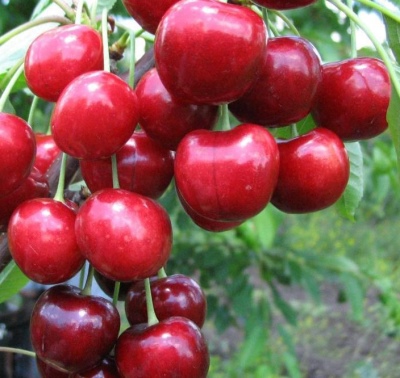
- Fruit shape: rounded
- Peduncle: medium length and thickness
- Authors: L.I. Taranenko (Donetsk branch of the Institute of Horticulture UAAS)
- Appeared when crossing: Donetsk woman x Valery Chkalov
- Year of approval: 2000
- Growth type: vigorous
- Appointment: universal
- Tree height, m: 4
- Crown: roundish-spreading, spherical, medium density
- Escapes: thick, straight, brown-brown, naked
The sweet cherry variety Annushka is a popular horticultural crop that has found its application in modern agriculture. This variety has a rich and unusual taste. Many positive characteristics, including excellent yield and disease resistance, helped this variety quickly gain the trust of Russian agronomists.
Description of the variety
Vigorous trees grow up to 4 meters in height, but some of them can stretch up to five meters. The crown, average in density, takes the shape of a ball, the structure is spreading. Shoots are massive and straight, covered with brown-brown bark. Mixed kidneys.
The leaves are elongated and large, with a standard oval shape. Edges are crenate. Each leaf is held on a one and a half centimeter long handle. Color - light green. Flowers are collected from snow-white petals, collected in buds of 5 pieces. The Annushka variety has a high frost resistance, this applies to both wood and flower buds. Trees calmly endure frosts down to –30 degrees Celsius.
Fruit characteristics
Large-sized berries gain weight from 9 to 10 grams on average. The shape is standard, rounded. The color of the skin and pulp is the same - thick, dark red. The length and thickness of the peduncle are medium. The pulp is one of the main advantages of this variety. It is very juicy, tender and at the same time moderately dense. The medium round seed is easily detached from the berry. The separation is dry.
The purpose of the crop is universal. Berries are used both for the preparation of sweet treats and for eating in their natural form. This way you can get the most out of it.
Taste qualities
The taste of ripe fruits is marked as sweet, dessert. Due to its high gastronomic qualities, the sweet cherry was highly rated by the tasters at 4.8 points. The percentage of acids - 0.7, sugars - 10.4, dry matter - 25.4.
Ripening and fruiting
The first crop will be harvested only in the fifth year after planting the trees. Ripening time is medium, and flowering time is medium late.

Yield
The average yield is 75 centners per hectare of garden. Good transportability made it possible to grow this variety for sale. Trees will delight you with a rich harvest if the seedlings that were purchased in the spring were able to successfully survive the winter. Under the influence of low temperatures, hardening occurs, which has a beneficial effect on the growth of plants and their fruiting.
Growing and care
The Annushka variety does not have any special requirements for keeping and growing, and its agricultural technology practically does not differ from caring for other types of sweet cherries. Even despite the unpretentiousness, it will not be possible to achieve high yields without performing certain agronomic measures.
Proper care of a fruit crop is as follows.
The garden is watered three times throughout the year. The first time irrigation is carried out in the spring, during flowering.After that, the soil is moistened in May, when the fruits ripen, and before winter frosts. Small pits 30 centimeters deep are made around the tree. 25 liters of settled water are poured into each pit.
In the second year after planting, the trees begin to fertilize. Organic matter and urea are introduced into the soil around the trunk circle. The amount of dressing increases from year to year. In the fourth year of life, the plants use potassium salt and superphosphate.
Pruning is needed not only for a neat appearance, but also for stable fruiting. Excessive branches impede proper ventilation and prevent the sun's rays from warming the berries. In the first few years of the cherry's life, you need to cut off the growths up to 1.5 meters in length. And also pruning of shoots is performed. In the diagonal direction, the semi-skeletal branches are fixed and tied, and the formative pruning is performed using a secateurs.
To reduce the acidity of the soil, lime is added to it. The work must be done every 10 years. This procedure improves the quality of the soil and contributes to its saturation with useful microcomponents.
Before the onset of cold weather, the tree trunk is covered with whitewash. To prepare the solution, you need to mix clay, vitriol and lime.
With normal care, cherries will bear fruit for more than a dozen years. All cut sites must be treated with garden pitch to avoid contamination, and the work is done only with a sharp and clean tool.




Disease and pest resistance
The sweet cherry variety Annushka demonstrates high resistance to infections and diseases that often attack fruit crops. The health of trees largely depends on adherence to agricultural practices. Juicy and bright berries attract the attention of harmful insects. If the trees grow in a comfortable environment, preventive measures are not necessary. Otherwise, you can use both ready-made compositions and folk recipes.

































































